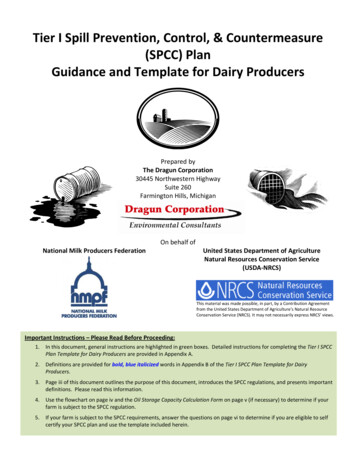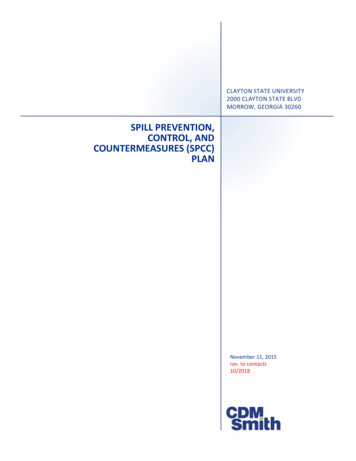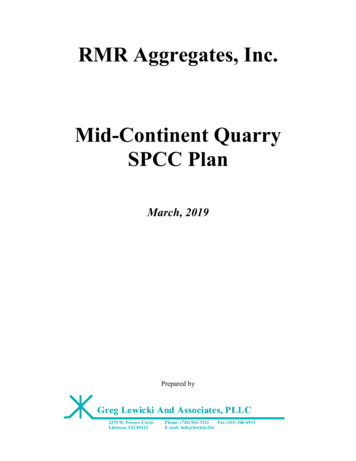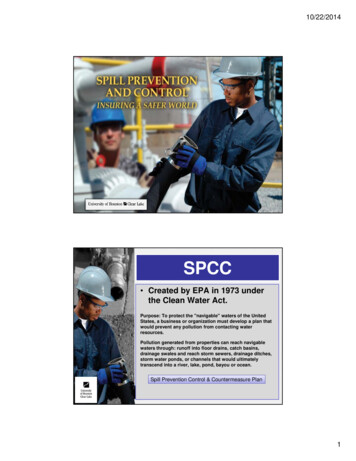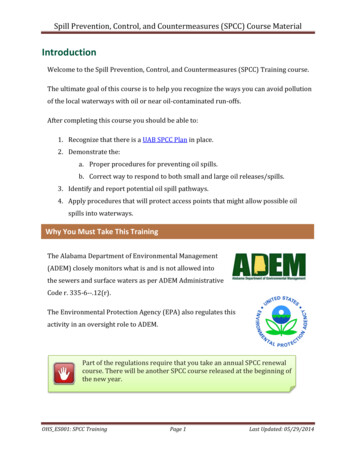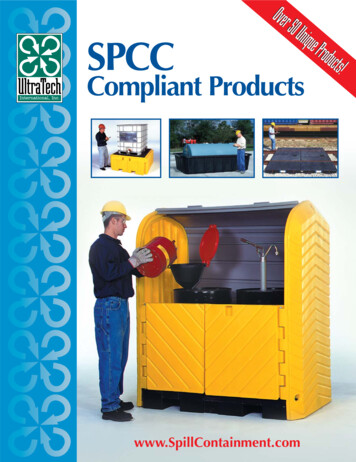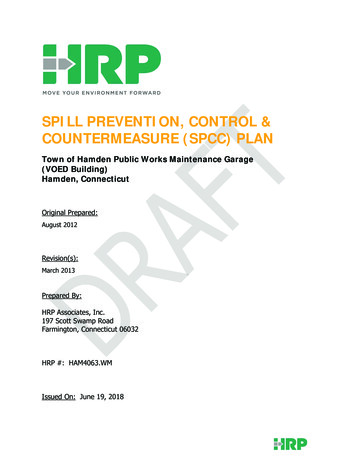
Transcription
Chapter 2 SPCC Rule Applicability2.1IntroductionThe SPCC rule establishes requirements to prepare and implement SPCC Plans. SPCC Plans complementexisting laws, regulations, rules, standards, policies, and procedures pertaining to safety, fire prevention, and oilpollution prevention. The purpose of an SPCC Plan is to form a comprehensive oil spill prevention program thatminimizes the potential for discharges. The SPCC Plan must address all relevant spill prevention, control, andcountermeasures necessary at the specific facility.The rule applies to the owners and operators of nontransportation-related onshore and offshore facilities thatcould reasonably be expected to discharge oil into navigablewaters of the United States or adjoining shorelines inquantities that may be harmful. This chapter clarifies whichfacilities, activities, and equipment are subject to the SPCCrule. The facility owner/operator is responsible fordetermining whether the facility is subject to the SPCC rule,however, this determination is subject to review by theRegional Administrator or his delegated representative.2.1.1 Summary of General ApplicabilitySection 112.1 establishes the general applicability ofthe SPCC rule. The SPCC rule applies to facilities that:§112.1(b).this part applies to any owner or operator of anon-transportation-related onshore or offshorefacility engaged in drilling, producing, gathering,storing, processing, refining, transferring,distributing, using, or consuming oil and oilproducts, which due to its location, couldreasonably be expected to discharge oil inquantities that may be harmful, as described inpart 110 of this chapter, into or upon thenavigable waters of the United States oradjoining shorelines.Note: The above text is an excerpt of the SPCC rule. Referto 40 CFR part 112 for the full text of the rule. Are non-transportation-related; Have an aboveground oil storage capacity of more than 1,320 U.S. gallons or a completelyburied oil storage capacity greater than 42,000 U.S; and Could reasonably be expected to discharge oil to navigable waters or adjoining shorelines inquantities that may be harmful.Facilities that are owned and operated by federal, state, local government or tribal entities are equallysubject to the regulation20 as any other facility (although the federal government is not subject to civilpenalties). Unlike some other federal environmental programs, the Clean Water Act does not authorize EPA todelegate the SPCC program implementation or enforcement to State, local, or tribal representatives.P20PThe SPCC rule requires an owner or operator to develop an SPCC Plan. Under the CWA the definition of owner or operatorincludes “person” which includes federal, state and local government or tribal entities (33 USC 1362(4) (CWA Section 502(4))).SPCC GUIDANCE FOR REGIONAL INSPECTORSDecember 16, 20132-1
Chapter 2: ApplicabilityApplicabilitySpecifically, EPA exempts:-Any facility where the completely buried oil storage capacity is 42,000 U.S. gallons or less and the aggregateaboveground oil storage capacity is 1,320 U.S. gallons or less;-Completely buried oil tanks and associated piping and equipment that are subject to all of the technicalrequirements under 40 CFR part 280 or 281;-Underground oil storage tanks, including below-grade vaulted tanks that supply emergency diesel generatorsat a nuclear power generation facility licensed by the Nuclear Regulatory Commission (NRC) and subject to anyNRC provision regarding design and quality criteria, including but not limited to 10 CFR part 50;-Permanently closed oil containers;-Any container with an oil storage capacity less than 55 U.S. gallons;-Any facility or part thereof used exclusively for wastewater treatment;-Motive power oil containers;-Hot-mix asphalt or any hot-mix asphalt container;-Containers storing heating oil used solely at a single-family residence;-Pesticide application equipment or related mix containers (with adjuvant oil);-Intra-facility oil gathering lines subject to the regulatory requirements of 49 CFR part 192 or 195; and-Any milk and milk product container and associated piping and appurtenance.Do not include exempt oil containers or oil equipment when calculating the total oil storage capacity of the facility. (see§112.1(d))Section 112.1(d) describes facilities subject to EPA jurisdiction (i.e., that are non-transportation-related)and the activities and equipment that are exempt from the SPCC rule and from the facility total oil storagecapacity calculations. The section also describes the types of facilities that are outside EPA jurisdiction andtherefore not subject to the SPCC rule. Notwithstanding the exemptions provided in §112.1(d), under §112.1(f)the Regional Administrator has discretion to require the owner or operator of any facility, subject to EPA’sjurisdiction under §311(j) of the Clean Water Act (CWA), to prepare and implement an SPCC Plan, or part of anSPCC Plan.This chapter further explains each of the applicability criteria listed in §112.1 and provides examples ofhow these criteria are applied. The remainder of this chapter is organized as follows: Section 2.2 discusses the definition of “oil” and the regulated activities. Section 2.3 discusses activities involving oil. Section 2.4 explains what a “facility” is and provides examples of how a facility can bedetermined.SPCC GUIDANCE FOR REGIONAL INSPECTORSDecember 16, 20132-2
Chapter 2: Applicability2.2 Section 2.5 discusses the difference between “transportation-related” and “non-transportationrelated” facilities in determining jurisdiction of regulatory agencies. Section 2.6 discusses the criteria for a facility to have a “reasonable expectation of a dischargeto navigable waters in quantities that may be harmful.” Section 2.7 addresses storage capacity thresholds and methods of calculating storage capacity. Section 2.8 addresses the exemptions to the SPCC rule. Section 2.9 discusses the process for a Regional Administrator to determine applicability,outside of the exemptions listed in §112.1(d). Section 2.10 addresses the applicability of the rule requirements to different kinds ofcontainers. Section 2.11 discusses the applicability of Facility Response Plan (FRP) requirements. Section 2.12 describes the role of the EPA inspector.Definition of OilThe SPCC rule applies to the owners and operators offacilities with the potential to discharge oil in quantities thatmay be harmful to navigable waters or adjoining shorelines.The SPCC rule’s definition of oil derives from §311(a)(1) ofthe Clean Water Act (CWA) which defines oil as “oil of anykind or in any form, including, but not limited to, petroleum,fuel oil, sludge, oil refuse, and oil mixed with wastes otherthan dredged spoil.”§112.2Oil means oil of any kind or in any form,including, but not limited to: fats, oils, or greasesof animal, fish, or marine mammal origin;vegetable oils, including oils from seeds, nuts,fruits, or kernels; and, other oils and greases,including petroleum, fuel oil, sludge, syntheticoils, mineral oils, oil refuse, or oil mixed withwastes other than dredged spoil.OPA §1001 defined oil separately to exclude anysubstance which is specifically listed or designated as aNote: The above text is an excerpt of the SPCC rule. Referhazardous substance under Comprehensive Environmentalto 40 CFR part 112 for the full text of the rule.Response, Compensation, and Liability Act (CERCLA) andwhich is subject to provisions of that Act. 21 Although oil isdefined separately under OPA, that definition did not amend the original CWA definition of oil in §311(a)(1) andtherefore was not incorporated into the definition of oil under 40 CFR part 112.2 that applies to both SPCC andFRP regulatory requirements.P21PUnder OPA, “oil” means “oil of any kind or in any form, including petroleum, fuel oil, sludge, oil refuse, and oil mixed withwastes other than dredged spoil, but does not include any substance which is specifically listed or designated as a hazardoussubstance under subparagraphs (A) through (F) of section 101(14) of the Comprehensive Environmental Response,Compensation, and Liability Act (42 U.S.C. 9601) and which is subject to the provisions of that Act.”SPCC GUIDANCE FOR REGIONAL INSPECTORSDecember 16, 20132-3
Chapter 2: ApplicabilityIn response to Edible Oil Regulatory Reform Act (EORRA) of 1995 (33 U.S.C. 2720) requirements, the oildefinition under §112.2 was revised to include the categories of oil in EORRA. Those categories are: (1)petroleum oils, (2) animal fats and vegetable oils; and, (3) other non-petroleum oils and greases.22PSection 112.2 of the SPCC rule defines oil as “oil of any kind or in any form, including, but not limited to:fats, oils, or greases of animal, fish, or marine mammal origin; vegetable oils, including oils from seeds, nuts,fruits, or kernels; and, other oils and greases, including petroleum, fuel oil, sludge, synthetic oils, mineral oils, oilrefuse, or oil mixed with wastes other than dredged spoil.”The U.S. Coast Guard (USCG) maintains a separate list of substances it considers oil for its regulatorypurposes. The list is available on the USCG Web site and may be used as a guide when determining if a particularsubstance is an oil.23 However, it is important to note that for purposes of EPA’s regulations, the USCG list is notcomprehensive and does not include all oils that are subject to 40 CFR part 112. The sections below discusswhether or not specific substances are considered oils for purposes of SPCC regulation.PP2.2.1 Petroleum Oils and Non-Petroleum OilsThe SPCC rule applies to both petroleum oils and non-petroleum oils. Petroleum oils include, but are notlimited to, crude and refined petroleum products, asphalt, gasoline, fuel oils, mineral oils, naphtha, sludge, oilrefuse, and oil mixed with wastes other than dredged spoil. Nonpetroleum oils and greases include coal tar,creosote, silicon fluids, pine oil, turpentine, and tall oils. (67 FR 47075, July 17, 2002).Subpart B of 40 CFR part 112 covers both “petroleum oils and non-petroleum oils.” Petroleum oils andnon-petroleum oils, including synthetic oils, share common physical properties and produce similarenvironmental effects. Petroleum and non-petroleum oils can enter all parts of an aquatic system and adjacentshoreline, and similar methods of containment, removal and cleanup are used to reduce the harm created byspills of both types of oils.2.2.2 Synthetic OilsSynthetic oils are used in a wide range of applications, including as heat transfer fluids, engine fluids,hydraulic and transmission fluids, metalworking fluids, dielectric fluids, compressor lubricants, and turbinelubricants. Synthetic oils are created by chemical synthesis rather than by refining petroleum crude or extractingoil from plant seeds. Oils that are derived from plant material may be considered animal fats and vegetable oilsunder subpart C of 40 CFR part 112.22EPA provided notice in 1975 that affirmed that animal fats and vegetable oils (AFVOs) were subject to the SPCC rule (40 FR28849, July 9, 1975). For more information see Chapter 1: Introduction.23See the “List of Petroleum and Non-Petroleum Oils” on the USCG Web site at http://www.uscg.mil/vrp/faq/oil.shtml under“Additional References.”SPCC GUIDANCE FOR REGIONAL INSPECTORSDecember 16, 20132-4
Chapter 2: Applicability2.2.3 Animal Fats and Vegetable Oils (AFVO)Animal fats and vegetable oils are covered under the SPCC regulation. Animal fats include but are notlimited to fats, oils, and greases of animal origin (for example, lard and tallow), fish (for example, cod liver oil), ormarine mammal origin (for example, whale oil).Vegetable oils include but are not limited to oils ofvegetable origin, including oils from seeds, nuts, fruits, andkernels. Examples of vegetable oils include: corn oil,rapeseed oil, coconut oil, palm oil, soy bean oil, sunflowerseed oil, cottonseed oil, and peanut oil. (67 FR 47075, July17, 2002).2.2.4 Asphalt§112.2Animal fat means a non-petroleum oil, fat, orgrease of animal, fish, or marine mammal origin.Vegetable oil means a non-petroleum oil or fat ofvegetable origin, including but not limited to oilsand fats derived from plant seeds, nuts, fruits,and kernels.Note: The above text is an excerpt of the SPCC rule. ReferAsphalt is a thermoplastic material, composed ofto 40 CFR part 112 for the full text of the rule.unsaturated aliphatic and aromatic compounds, thatsoftens when heated and hardens upon cooling. Within acertain temperature range, it exhibits viscoelastic properties with viscous flow behavior and elastic deformation.All types of asphalt are petroleum oil products, and its composition depends on the source of the crude oil andthe process used to manufacture it.The SPCC rule applies to asphalt cement (AC), as well as to asphalt derivatives such as cutbacks andemulsions. Because of the operational conditions under which AC, cutbacks and emulsions are used and stored,they do pose a risk of being discharged into navigable waters or adjoining shorelines. Although AC) is semi-solidor solid at ambient temperature and pressure, it is generally stored at elevated temperatures. Hot AC is liquid—similar to other semi-solid oils, such as paraffin wax and heavy bunker fuels—and therefore is capable offlowing. Cutbacks and emulsions are liquid at ambient temperature, and because of their low viscosity, they mayflow when discharged onto the ground. All of these oils are regulated under the SPCC rule to prevent dischargesto navigable waters or adjoining shorelines.However, hot-mix asphalt (HMA) and HMA containers are exempt from the SPCC rule. HMA is a blend ofAC and aggregate material, such as stone, ground tires, sand, or gravel, which is formed into final pavingproducts for use on roads and parking lots. HMA is unlikely to flow as a result of the entrained aggregate, suchthat there would be very few circumstances, if any, in which a discharge of HMA would have the potential toreach navigable waters or adjoining shorelines.2.2.5 Natural Gas and CondensateThe SPCC rule does not apply to natural gas (including liquid natural gas and liquid petroleum gas). EPAdoes not consider highly volatile liquids that volatilize on contact with air or water, such as liquid natural gas orliquid petroleum gas, to be oil (67 FR 47076, July 17, 2002). Furthermore, EPA has stated that hydrocarbons in aSPCC GUIDANCE FOR REGIONAL INSPECTORSDecember 16, 20132-5
Chapter 2: Applicabilitygaseous phase under ambient pressure and temperature, such as natural gas, present at SPCC regulatedfacilities are not regulated under the SPCC rule (73 FR 74271, December 5, 2008).However, natural gas liquid condensate (often referred to as “natural gasoline” or “drip gas”) is an oilsubject to the SPCC rule. Condensate can accumulate in tanks, containers, or other equipment. For the purposesof determining SPCC applicability, containers with 55 gallons or more in capacity storing condensate must beincluded in a natural gas facility’s total oil storage capacity calculation.More information on specific types of facilities handling both natural gas and oil and how they areregulated under the SPCC rule can be found in Section 2.4.7.2.2.6 Oil and Water MixturesOil and water mixture containers are subject to the SPCC rule. A mixture of wastewater and oil is ‘‘oil’’under the statutory and regulatory definition of the term (33 U.S.C. 1321(a)(1) and 40 CFR 110.2 and 112.2). Adischarge of wastewater containing oil to navigable waters or adjoining shorelines in a ‘‘harmful quantity’’ (40CFR part 110) is prohibited (see July 17, 2002, 67 FR 47069). One example of an oil and water mixture isproduced water.2.2.7 Produced WaterThe SPCC rule applies to produced water from an oilwell. Produced water is the oil and water mixture resultingfrom the separation of crude oil or gas from the fluids orgases extracted from the oil/gas reservoir, prior to disposal,subsequent use (e.g., re-injection or beneficial reuse), orfurther treatment. Produced water’s chemical and physicalcharacteristics vary considerably depending on the geologicformation, usually being commingled with oil and gas at thewellhead, and changing in composition as the oil or naturalgas fraction is separated and sent to market.§112.2Produced water container means a storagecontainer at an oil production facility used tostore the produced water after initial oil/waterseparation, and prior to reinjection, beneficialreuse, discharge, or transfer for disposal.Note: The above text is an excerpt of the SPCC rule. Referto 40 CFR part 112 for the full text of the rule.Produced water is typically collected in produced water containers at the end of the oil and gastreatment process, and often accumulates emulsified oil not captured in the separation process. Under normaloperating conditions, a layer of oil may be present on top of the fluids. The amount of oil by volume observed inproduced water storage containers varies, but based on EPA’s assessment, is generally estimated to range fromless than one to ten percent by volume, and can be greater. Oil may be present not only in free phase, but alsoin other forms, such as in a dissolved phase, emulsion or a sludge at the bottom of the produced watercontainer.Oil discharges to navigable waters or adjoining shorelines from an oil/water mixture in a produced watercontainer may cause harm. Such mixtures24 are regulated as oil under the SPCC rule. Therefore, the capacity ofP24PRefers to mixtures in the produced water container.SPCC GUIDANCE FOR REGIONAL INSPECTORSDecember 16, 20132-6
Chapter 2: Applicabilityproduced water containers counts toward the facility aggregate oil storage capacity. Produced water containersat oil production, oil recycling or oil recovery facilities are not eligible for the wastewater treatment exemptionin §112.1(d)(6).2.2.8 Hazardous Substances and Hazardous WasteThe definition of “oil” in §112.2 includes but is not limited to “oil mixed with wastes other than dredgedspoil.” Oils covered under the SPCC rule include certain hazardous substances or hazardous wastes that are oils,as well as certain hazardous substances or hazardous wastes that are mixed with oils. Containers storing thesesubstances may also be covered by other regulations, such as the Resource Conservation and Recovery Act(RCRA) or CERCLA (also known as Superfund). For example, the definition of oil under §112.2 includes “used oil”because it is an oil mixed with wastes. “Used oil,” as defined in EPA’s Standards for the Management of Used Oilat 40 CFR 279.1, means any oil that has been refined from crude oil, or any synthetic oil, that has been used andas a result of such use is contaminated by physical or chemical impurities.Inspectors should evaluate whether containers storing hazardous substances or mixtures of wastescontain oil. Hazardous substances or hazardous wastes that are neither oils nor mixed with oils are not subjectto SPCC rule requirements. For purposes of 40 CFR part 112, the CWA §311(b)(2) hazardous substances asidentified under 40 CFR part 116 are not considered oils. However, an oil mixture that includes a CWA hazardoussubstance is subject to 40 CFR part 112 when it meets the definition of oil in the regulation. For example,benzene is a CWA hazardous substance and therefore does not meet the definition of oil in §112.2; however,benzene is a constituent of gasoline which is a mixture that includes other oils. Gasoline is an oil as definedunder 40 CFR part 112.2.Although the rule contains an exemption for completely buried tanks that are subject to all undergroundstorage tank (UST) technical requirements of 40 CFR part 280 and/or a state program approved under part 281under §112.1(d)(2)(i) or (4), tanks containing RCRA hazardous wastes are not subject to the UST rules. Therefore,when RCRA hazardous wastes tanks located at a facility subject to the SPCC rule also contain oil, they are subjectto the SPCC rule requirements.2.2.9 Denatured Ethanol used in Renewable FuelsRenewable fuels, such as E85 or “flex fuel” (15% unleaded gasoline and 85% ethanol) are produced in ablending process.25 Ethanol used for fuel often contains a denaturing additive (typically gasoline, naturalgasoline, diesel fuel or other oil petroleum product) which is oil. Therefore, the final denatured ethanol is alsoconsidered an oil, and facilities handling or storing denatured ethanol may be subject to the SPCC requirements.An EPA letter dated November 7, 2006 details the Agency’s position on denatured ethanol (see Appendix H).P25PFor more information on ethanol renewable fuels /pdf/ethanol plants manual.pdfSPCC GUIDANCE FOR REGIONAL INSPECTORSDecember 16, 20132-7
Chapter 2: Applicability2.2.10 Biodiesel and Biodiesel BlendsBiodiesel and biodiesel blends are other types of renewable fuels that are often stored and handled atfacilities regulated under 40 CFR part 112.26 Biodiesel, designated B100, is a domestic, renewable fuel for dieselengines derived from natural oils like soybean oil. Biodiesel is comprised of mono-alkyl esters of long chain fattyacids derived from vegetable oils or animal fats.PPBiodiesel can be used in any concentration with petroleum-based diesel fuel in existing diesel engineswith little or no modification. Biodiesel is not the same as raw vegetable oil. It is produced by a chemical processwhich removes the glycerin from the oil. Biodiesel is typically produced by a reaction of a vegetable oil or animalfat with an alcohol such as methanol or ethanol in the presence of a catalyst to yield mono-alkyl esters andglycerin, which is removed.Biodiesel blends are a blend of biodiesel fuel with petroleum-based diesel fuel, designated BXX, whereXX represents the volume percentage of biodiesel fuel in theblend. Both biodiesel (B100) and biodiesel blends are§112.1(b)considered oil for the purposes of 40 CFR part 112.2.3Activities Involving OilSection 112.1(b) specifies the following oil-relatedactivities are regulated under the SPCC rule: “drilling,producing, gathering, storing, processing, refining,transferring, distributing, using, or consuming oil and oilproducts.” These activities are subject to SPCC provided thefacility meets the other applicability criteria in §112.1. Table2-1 provides examples of these activities.26.this part applies to any owner or operator of anon-transportation-related onshore or offshorefacility engaged in drilling, producing, gathering,storing, processing, refining, transferring,distributing, using, or consuming oil and oilproducts.Note: The above text is an excerpt of the SPCC rule. Referto 40 CFR part 112 for the full text of the rule. Emphasisadded.For more information on biodiesel renewable fuels /pdf/biodiesel manual.pdfSPCC GUIDANCE FOR REGIONAL INSPECTORSDecember 16, 20132-8
Chapter 2: ApplicabilityTable 2-1:Examples of some oil-related activities that may be regulated under 40 CFR part 112.27PActivityExamples of Oil-related Regulated ActivitiesDrillingDrilling a well to extract crude oil or natural gas and associated products (such as wet natural gas) froma subsurface fieldProducingExtracting product from a well and separating the crude oil and/or gas from other associated products(e.g., water, sediment)GatheringCollecting oil from numerous wells, tank batteries, or platforms and transporting it to a main storagefacility, processing plant, or shipping pointStoringStoring oil in containers prior to use, while being used, or prior to further distribution in commerceProcessingTreating oil using a series of processes to prepare the oil for commercial use, consumption, furtherrefining, manufacturing, or distributionRefiningSeparating crude oil into different types of hydrocarbons through distillation, cracking, reforming, andother processes; separating animal fats and vegetable oils from free fatty acids and other impuritiesTransferringTransferring oil between containers, such as between a railcar or tank truck and a bulk storagecontainer, or between stock tanks and manufacturing equipmentDistributingSelling or marketing oil for further commerce or moving oil using equipment such as highway vehicles,railroad cars, or pipeline systems in the confines of a non-transportation-related facility. Note thatbusinesses commonly referred to as oil distributors and retailers are also “storing” oil, as describedaboveUsingUsing oil for mechanical or operational purposes in a manner that does not significantly reduce thequantity of oil, such as using oil to lubricate moving parts, provide insulation, or for other purposes inelectrical equipment, electrical transformers, and hydraulic equipmentConsumingConsuming oil in a manner that reduces the amount of oil, such as burning as fuel in a generator2.4Facilities2.4.1 Definition of FacilityThe definition of “facility” governs the overall applicability of 40 CFR part 112, and thus is used todetermine the scope of a facility’s boundaries in order to determine if the facility is subject to the SPCC and/orFRP requirements. The boundary or extent of a “facility” depends on site-specific circumstances. Factors thatmay be considered relevant in delineating the boundaries of a facility under 40 CFR 112 may include, but are notlimited to:27 Ownership, management, and operation of the buildings, structures, equipment, installations,pipes, or pipelines on the site; Similarity in functions, operational characteristics, and types of activities occurring at the site;The examples listed in this table are not exhaustive and are for illustrative purposes only.SPCC GUIDANCE FOR REGIONAL INSPECTORSDecember 16, 20132-9
Chapter 2: Applicability Adjacency; or Shared drainage pathways (e.g., same receiving water bodies).The facility owner or operator, or a Professional Engineer (PE) on behalf of the facility owner/operator,must make a judgment of what constitutes the “facility.”Once the owner or operator determines the facility§112.2boundaries for purposes of the SPCC rule, then the sameFacility means any mobile or fixed, onshore orboundaries apply for FRP applicability. Note that generally,offshore building, property, parcel, lease,an SPCC-regulated facility excludes components that are notstructure, installation, equipment, pipe, orsubject to EPA’s jurisdiction, but are instead subject solely topipeline (other than a vessel or a public vessel)the jurisdiction of other agencies, such as the Department ofused in oil well drilling operations, oil production,oil refining, oil storage, oil gathering, oilTransportation (DOT) or the United States Coast Guardprocessing, oil transfer, oil distribution, and oil(USCG).Contiguous or non-contiguous buildings, properties,parcels, leases, structures, installations, pipes, or pipelinesunder the ownership or operation of the same person maybe considered separate facilities for SPCC purposes. Forexample, a single facility may be composed of various oilcontaining areas spread over a relatively large campus, suchas multiple operational areas within a military base. Eachoperational area may be considered a separate facility. Themilitary base may not necessarily include single-familyhomes occupied by military personnel as part of the facility ifthese are considered personal space similar to civilian singlefamily residences. However, larger military barracks forwhich a branch of the military controls, operates, andmaintains the space would be included as part of a facility.waste treatment, or in which oil is used, asdescribed in appendix A to this part. Theboundaries of a facility depend on several sitespecific factors, including but not limited to, theownership or operation of buildings, structures,and equipment on the same site and types ofactivity at the site. Contiguous or non-contiguousbuildings, properties, parcels, leases, structures,installations, pipes, or pipelines under theownership or operation of the same person maybe considered separate facilities. Only thisdefinition governs whether a facility is subject tothis part.Note: The above text is an excerpt of the SPCC rule. Referto 40 CFR part 112 for the full text of the rule.While the facility owner/operator has some discretion in defining the parameters of the facility, theboundaries of a facility may not be drawn to solely avoid regulation under 40 CFR part 112. For example, twocontiguous operational areas, each with 700 gallons in aboveground storage capacity, that have the sameowner, perform similar functions, are attended by the same personnel, and are in other ways indistinguishablefrom each other, would reasonably be expected to represent a single facility under the SPCC rule, and wouldtherefore be required to have an SPCC Plan, since the capacity of this facility is above the 1,320-gallonaboveground threshold. These two operational areas would not be defined as two separate facilities under thedefinition of “facility” in §112.2. EPA reserves the right to make its own facility boundary determination afterreviewing the Plan or inspecting the facility.The facility owner and operator is responsible for ensuring that an SPCC Plan is prepared. A single sitemay have multiple owners and/or operators, and therefore may be divided into multiple facilities. Factors toSPCC GUIDANCE FOR REGIONAL INSPECTORSDecember 16, 20132-10
Chapter 2: Applicabilityconsider in determining which owner or operator should prepare the Plan include who has control over day-today operations of the facility or particular containers and equipment, who trains the employee(s) involved in oilhandling activities, who will conduct the required inspections and tests, and who will be responsible forresponding to and cleaning up any discharge of oil. EPA expects that the owners and operators will cooperate toprepare one or more Plans, as appropriate, to be kept at each facility when attended more than four hours perday.SPCC facil
- Any facility where the completely buried oil storage capacity is 42,000 U.S. gallons or less and the aggregate aboveground oil storage capacity is 1,320 U.S. gallons or less; - Completely buried oil tanks and associated piping and equipment that are subject to all of the technical requirements under 40 CFR part 280 or 281;

